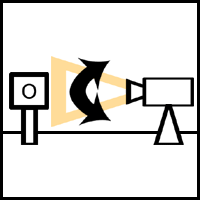Pan
 This is where you move your camera horizontally, either left to right or right to left. Whilst the camera is being moved horizontally it is fixed to a base which gives a slicker effect on screen. This can be used to follow the action or get a sense of location in the story. The view seems to 'pass by'. It is short for a panorama, suggesting there is an expansive view that exceeds the gaze.
This is where you move your camera horizontally, either left to right or right to left. Whilst the camera is being moved horizontally it is fixed to a base which gives a slicker effect on screen. This can be used to follow the action or get a sense of location in the story. The view seems to 'pass by'. It is short for a panorama, suggesting there is an expansive view that exceeds the gaze. Tilt
 This is similar to the pan except it rotates up and down in a vertical plane. The camera is in a fixed position once again and it replicates someone turning their head to look up and down. This technique is generally used to establish an object or character and their importance or important aspects. Typically a tripod is used to keep the camera stationary and move to the angle it is pointing to.
This is similar to the pan except it rotates up and down in a vertical plane. The camera is in a fixed position once again and it replicates someone turning their head to look up and down. This technique is generally used to establish an object or character and their importance or important aspects. Typically a tripod is used to keep the camera stationary and move to the angle it is pointing to. Tracking
 This is similar to a panning shot going from left to right or right to left and the camera also moves vertically/horizontally along with the action. Tracking shots are used to establish action, create tension and show the enormity of the task or the heroic status of the characters.
This is similar to a panning shot going from left to right or right to left and the camera also moves vertically/horizontally along with the action. Tracking shots are used to establish action, create tension and show the enormity of the task or the heroic status of the characters.
Dolly
Crane
This is when a camera is mounted to a stabiliser to establish a smooth shot even when moving quickly over uneven surfaces. It combines the steadiness of a tripod shot with the fluid motion of a dolly.
Hand-held
This shot is taken when the camera is held by hand as opposed to being mounted. It gives a shakier effect and the 'shaky camera' can also be emphasised by the operator during filming. The hand-held shot gives a make-shift feel whilst providing a sense of dynamics, immersion, instability and nervousness. This is the sort of camera movement I would like to feature a lot of in my short film as I feel it will be very fitting to the tension and atmosphere of the action.
Zoom
This is rather self explanatory but this is when the focal length of the lens is either increased or decreased. It can be a tracking zoom or static. Typically it's used to emphasise a particular moment, reaction or item. The speed of the zoom can vary from slow to fast depending on the effect the director intends to have on the audience.

Reverse zoom
This is when the camera is moving towards the background while zooming out or, vice versa, when the camera moves away from the background whilst the camera zooms in. It was first used by Hitchcock in Vertigo. It has a unique effect of the background's size increasing or decreasing while the subject stays around the same size. This is often used for realisation.


No comments:
Post a Comment